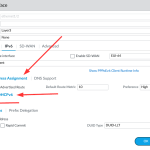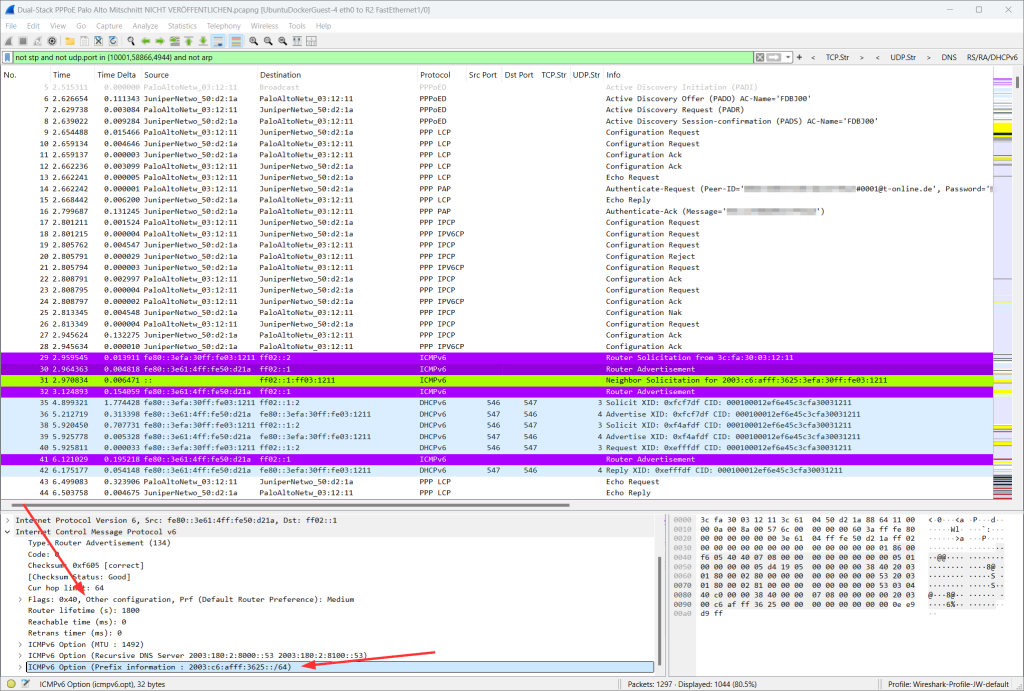
If you want to establish an Internet connection (that is: IPv6 and IPv4) right away from your firewall through xDSL connections, you need quite some technologies: PPPoE and PPPoEv6 (PPP IPV6CP) along with DHCPv6-PD. Fortunately, with PAN-OS 11.0 and 11.1, those missing IPv6 links were finally added by PANW to their Strata firewalls. (I have been awaiting them since 2015!)
So, here it is: Connecting a Palo through an xDSL modem to a residential ISP:
I’m using a PA-440 with PAN-OS 11.2.4-h2, connected through a DrayTek Vigor167 modem to the German ISP “Deutsche Telekom” on ethernet1/2. No VLAN config is needed since the DSL modem already encapsulates the traffic within VLAN 7 on the ISP side.
Side note: Unfortunately, we don’t have static IP addresses or static IPv6 subnets on most German residential ISPs. Hence, after every DSL reconnect or firewall reboot, we’ll get new public IPv4/IPv6 addresses along with a new IPv6 prefix. 🤦
PPPoE for legacy IP
Quite straightforward: Layer 3 interface of type PPPoE, adding username & password:


PPPoEv6 & DHCPv6-PD for IPv6
A few more options and submenus regarding IPv6. In addition, note the quite good documentation from Palo Alto Networks itself.
- Type PPPoEv6 Client, enable, and “Apply IPv4 Parameters” since the same login should be used
- followed by the address assignment that “Accept Router Advertised Route” along with the Autoconfig enabled, since, in my case, the firewall gets its WAN IPv6 address through a Router Advertisement (SLAAC) from the ISP’s router rather than through stateful DHCPv6
- still at the address assignment: enabling DHCPv6 but only with the Prefix Delegation options, giving the pool a name, in my case: DTAG. Note that the DHCP prefix length is just a hint and probably not honored by the ISP
- and finally, the DNS support, at least for the DNS resolver while the search list remains useless from the ISP





For IPv4 client networks, you can now add (sub-)interfaces with RFC 1918 addresses together with an SNAT rule using the WAN interface. For IPv6 downstream interfaces, you have to configure “Inherited” networks that are using a /64 prefix out of the proposed one from your ISP, such as shown here. No NAT is needed. ✅
Commit ;)
Client Runtime Information
Through the GUI, you can look up several runtime information such as the PPPoE and PPPoEv6 IP addresses, the DHCPv6-PD prefix, the actually assigned prefixes to downstream interfaces, the (default) routes within the forwarding table of the logical router, as well as appropriate system logs:








Some basic show commands are these: (Always remember that you can find all CLI commands concerning a keyword such as “pppoe” in the following way: find command keyword pppoe.)
weberjoh@pa-home> show pppoe interface ethernet1/2
Interface: ethernet1/2
PPPoE State: Connected
PPP State: Connected
Connected since: Mon Dec 16 14:12:39 2024
Connection up for: 0 days, 2:28:10
Access Concentrator: FDBJ00
AC MAC: 3c:61:04:50:d2:1a
Authentication via: PAP
Passive mode: Disabled
Username: 001234567890#098765432123#0001@t-online.de
Local IP: 84.139.79.37
Primary DNS IP: 217.237.150.51
Secondary DNS IP: 217.237.148.22
Primary WINS IP: 0.0.0.0
Secondary WINS IP: 0.0.0.0
Remote IP: 62.155.246.34
Session ID: 10
Link MTU: 1492
PPPoE/PPP Counters:
PPPoE control packets received: 2
PPPoE control packets sent: 2166
PPP control packets received: 2676
PPP control packets sent: 2655
weberjoh@pa-home>
weberjoh@pa-home>
weberjoh@pa-home> show pppoe ipv6 interface ethernet1/2
Interface: ethernet1/2
PPPoE State: Connected
PPP State: Connected
Connected since: Mon Dec 16 14:12:39 2024
Connection up for: 0 days, 2:28:46
Access Concentrator: FDBJ00
AC MAC: 3c:61:04:50:d2:1a
Authentication via: PAP
Passive mode: Disabled
Username: 001234567890#098765432123#0001@t-online.de
Session ID: 10
Link MTU: 1492
Client Identifier: 3e:fa:30:ff:fe:03:12:11
Server Identifier: 3e:61:04:ff:fe:50:d2:1a
Address Assignment:
Stateless Address Autoconfig: Enabled
DHCPv6 Config: Enabled
Current Address Assignment Mode: Stateless
Global IPv6 Address: 2003:c6:afff:4fe0:3efa:30ff:fe03:1211
Link Local IPv6 Address: fe80:0:0:0:3efa:30ff:fe03:1211
PPPoE/PPP Counters:
PPPoE control packets received: 2
PPPoE control packets sent: 2166
PPP control packets received: 2687
PPP control packets sent: 2666
Stateless Autoconfig:
SLAAC Address: 2003:c6:afff:4fe0:3efa:30ff:fe03:1211
Gateway: fe80:0:0:0:3e61:4ff:fe50:d21a
Managed flag: False
Valid lifetime: 14400
Preferred lifetime: 1800
Remaining Valid lifetime: 0 days, 3:51:54
Remaining Preferred lifetime: 0 days, 0:21:54
DHCPv6 Details:
Interface: ethernet1/2
Rapid Commit: Disabled
State: BOUND
Client:
Address: fe80::3efa:30ff:fe03:1211
DUID: 000100012ef2e3c73cfa30031211 (Type: LLT)
Server:
Address: fe80::3e61:4ff:fe50:d21a
DUID: 00020000058333633a36313a30343a35303a64373a6330000000
Preference: 0
Gateway: fe80::3e61:4ff:fe50:d21a
Remaining lease time: 0 days 21:31:18
IPv6 Address (IA_NA):
IPv6 Address (IA_TA):
Delegated Prefix:
IAID: 19000011
IPv6 Prefix (IA_PD):
Prefix: 2003:c6:af4f:6d00::/56
Preferred Lifetime (sec): 86400
Valid Lifetime (sec): 86400
DNS Server:
2003:180:2:8000::53
2003:180:2:8100::53
DNS Suffix:
Counters:
DHCPv6 control packets received: 3
DHCPv6 control packets sent: 3
RA control packets received: 18
RS control packets sent: 1
weberjoh@pa-home>
weberjoh@pa-home>
A Little Wiresharking
This is what it looks like on the wire between the Palo and the modem, captured with a real network TAP, the ProfiShark 1G. You can see the whole PPPoE process with its sub-protocols PPP LCP, PPP PAP, PPP IPCP, and PPP IPV6CP 😂, followed by an RA from the ISP with the O-flag and a prefix option (packet nr. 30, red arrows down below), the DAD message from the Palo (31), and the DHCPv6-PD process (35ff). This capturing took place at a later date, hence the shown IP addresses are different from the screenshots above. Never mind.
That’s it. Happy networking. ;)
Soli Deo Gloria!
Photo by Jonny Gios on Unsplash.


